Comprehensive Assessment of Water Footprints and Water Scarcity Pressure for Main Crops in Shandong Province, China
Abstract
:1. Introduction
2. Materials and Methods
2.1. Study Area
2.2. Data
2.3. Methods
3. Results
3.1. Temporal Changes of WF for Main Crops
3.1.1. Temporal Change of WF for Wheat
3.1.2. Temporal Change of WF for Maize
3.1.3. Temporal Change of WF for Cotton
3.1.4. Temporal Change of WF for Groundnut
3.2. Spatial Distribution of WF for Main Crops in Different Rainfall Years
3.2.1. Spatial Distribution of WF for Wheat
3.2.2. Spatial Distribution of WF for Maize
3.2.3. Spatial Distribution of WF for Cotton
3.2.4. Spatial Distribution of WF for Groundnut
3.3. Trends of Annual Total WF and WFblue for Main Crops
3.4. Pressure of Water Scarcity on Agriculture Productions
4. Discussion
5. Conclusions
Author Contributions
Funding
Acknowledgments
Conflicts of Interest
References
- Guo, B.; Chen, Y.N.; Shen, Y.J.; Li, W.H.; Wu, C.B. Spatially explicit estimation of domestic water use in the arid region of northwestern China: 1985–2009. Hydrol. Sci. J. 2013, 58, 162–176. [Google Scholar] [CrossRef] [Green Version]
- Shrestha, S.; Pandey, V.P.; Chanamai, C.; Ghosh, D.K. Green, Blue and Grey Water Footprints of Primary Crops Production in Nepal. Water Resour. Manag. 2013, 27, 5223–5243. [Google Scholar] [CrossRef]
- OECD. OECD Environmental Outlook to 2050: The Consequences of Inaction; OECD: Paris, France, 2012. [Google Scholar]
- Chapagain, A.K.; Hoekstra, A.Y. Water Footprints of Nations; Value of Water Research Report Series No. 16; UNESCO-IHE: Delft, The Netherlands, 2004. [Google Scholar]
- Zhuo, L.; Mekonnen, M.M.; Hoekstra, A.Y. Sensitivity and uncertainty in crop water footprint accounting: A case study for the Yellow River basin. Hydrol. Earth Syst. Sci. 2014, 18, 2219–2234. [Google Scholar] [CrossRef]
- Miglietta, P.P.; Leo, F.D.; Toma, P. Environmental Kuznets curve and the water footprint: An empirical analysis. Water Environ. J. 2016, 31, 20–30. [Google Scholar] [CrossRef]
- Hoekstra, A.Y.; Chapagain, A.K.; Aldaya, M.M.; Mekonnen, M.M. The Water Footprint Assessment Manual: Setting the Global Standard; Earthscan: London, UK, 2011. [Google Scholar]
- Hoekstra, A.Y.; Chapagain, A.K. The blue, green and grey water footprint of rice from production and consumption perspectives. Ecol. Econ. 2011, 70, 749–758. [Google Scholar]
- Sun, S.K.; Wu, P.T.; Wang, Y.B.; Zhao, X.N. The virtual water content of major grain crops and virtual water flows between regions in China. J. Sci. Food Agric. 2013, 93, 1427–1437. [Google Scholar] [CrossRef]
- Cao, X.C.; Wu, P.T.; Wang, Y.B.; Zhao, X.N. Assessing blue and green water utilisation in wheat production of China from the perspectives of water footprint and total water use. Hydrol. Earth Syst. Sci. 2014, 18, 3165–3178. [Google Scholar] [CrossRef] [Green Version]
- Suttayakul, P.; Aran, H.; Suksaroj, C.; Mungkalasiri, J.; Wisansuwannakorn, R.; Musikavong, C. Water footprints of products of oil palm plantations and palm oil mills in Thailand. Sci. Total Environ. 2016, 542, 521–529. [Google Scholar] [CrossRef] [PubMed]
- Sun, S.; Wu, P.; Wang, Y.; Zhao, X.; Liu, J.; Zhang, X. The impacts of interannual climate variability and agricultural inputs on water footprint of crop production in an irrigation district of China. Sci. Total Environ. 2013, 444, 498–507. [Google Scholar] [CrossRef]
- Xu, Y.; Huang, K.; Yu, Y.; Wang, X. Changes in water footprint of crop production in Beijing from 1978 to 2012: A logarithmic mean Divisia index decomposition analysis. J. Clean. Prod. 2015, 87, 180–187. [Google Scholar] [CrossRef]
- Marano, P.R.; Filippi, A.R. Water Footprint in paddy rice systems. Its determination in the provinces of Santa Fe and Entre Rios, Argentina. Ecol. Indic. 2015, 56, 229–236. [Google Scholar] [CrossRef]
- Su, M.H.; Huang, C.H.; Li, W.Y.; Tso, C.T.; Lur, H.S. Water footprint analysis of bioethanol energy crops in Taiwan. J. Clean. Prod. 2015, 88, 132–138. [Google Scholar] [CrossRef]
- Lu, Y.; Zhang, X.; Chen, S.; Shao, L.; Sun, H. Changes in water use efficiency and water footprint in grain production over the past 35 years: A case study in the North China Plain. J. Clean. Prod. 2016, 116, 71–79. [Google Scholar] [CrossRef]
- Chu, Y.M.; Shen, Y.J.; Yuan, Z.J. Water footprint of crop production for different crop structures in the Hebei southern plain, North China. Hydrol. Earth Syst. Sci. 2017, 21, 3061–3069. [Google Scholar] [CrossRef] [Green Version]
- Martinezaldaya, M.; Llamas, M.R. Water Footprint Analysis (Hydrologic and Economic) of the Guadiana River Basin; Value of Water Research Report 35, No. 3; UNESCO-IHE Institute for Water Education: Delft, The Netherlands, 2009. [Google Scholar]
- Zeng, Z.; Liu, J.; Koeneman, P.H.; Zarate, E.; Hoekstra, A.Y. Assessing water footprint at river basin level: A case study for the Heihe River Basin in northwest China. Hydrol. Earth Syst. Sci. 2012, 16, 2771–2781. [Google Scholar] [CrossRef]
- Bocchiola, D.; Nana, E.; Soncini, A. Impact of climate change scenarios on crop yield and water footprint of maize in the Po valley of Italy. Agric. Water Manag. 2013, 116, 50–61. [Google Scholar] [CrossRef]
- Denis, D.M.; Kumar, M.; Srivastava, S.; Suryavanshi, S.; Denis, A.F.; Singh, R.; Yadav, A.; Mishra, H. A High Resolution Assessment of Water Footprint of Wheat to Understand Yield and Water Use Heterogeneity. Water Resour. Manag. 2016, 30, 2641–2649. [Google Scholar] [CrossRef]
- Roux, B.L.; Laan, M.V.D.; Vahrmeijer, T.; Bristow, K.L.; Annandale, J.G. Establishing and testing a catchment water footprint framework to inform sustainable irrigation water use for an aquifer under stress. Sci. Total Environ. 2017, 599–600, 1119–1129. [Google Scholar] [CrossRef]
- Jing, M.; Hoekstra, A.Y.; Hao, W.; Chapagain, A.K.; Dangxian, W. Virtual versus real water transfers within China. Philos. Trans. R. Soc. B-Biol. Sci. 2006, 361, 835–842. [Google Scholar]
- Bulsink, F.; Hoekstra, A.Y.; Booij, M.J. The water footprint of Indonesian provinces related to the consumption of crop products. Hydrol. Earth Syst. Sci. 2010, 14, 119–128. [Google Scholar] [CrossRef] [Green Version]
- Wang, W.; Yu, Z.; Zhang, W.; Shao, Q.; Zhang, Y.; Luo, Y.; Jiao, X.; Xu, J. Responses of rice yield, irrigation water requirement and water use efficiency to climate change in China: Historical simulation and future projections. Agric. Water Manag. 2014, 146, 249–261. [Google Scholar] [CrossRef]
- Wang, Y.B.; Wu, P.T.; Engel, B.A.; Sun, S.K. Application of water footprint combined with a unified virtual crop pattern to evaluate crop water productivity in grain production in China. Sci. Total Environ. 2014, 497–498, 1–9. [Google Scholar] [CrossRef] [PubMed]
- Cao, X.; Pute, W.U.; Wang, Y.; Zhao, X. Water Footprint of Grain Product in Irrigated Farmland of China. Water Resour. Manag. 2014, 28, 2213–2227. [Google Scholar] [CrossRef]
- Wang, Y.B.; Wu, P.T.; Engel, B.A.; Sun, S.K. Comparison of volumetric and stress-weighted water footprint of grain products in China. Ecol. Indic. 2015, 48, 324–333. [Google Scholar] [CrossRef]
- Zhuo, L.; Mekonnen, M.M.; Hoekstra, A.Y.; Wada, Y. Inter- and intra-annual variation of water footprint of crops and blue water scarcity in the Yellow River basin (1961–2009). Adv. Water Resour. 2016, 87, 29–41. [Google Scholar] [CrossRef]
- Lamastra, L.; Miglietta, P.P.; Toma, P.; Leo, F.D.; Massari, S. Virtual water trade of agri-food products: Evidence from italian-chinese relations. Sci. Total Environ. 2017, 599–600, 474–482. [Google Scholar] [CrossRef]
- Doll, P.; Siebert, S. Quantifying blue and green virtual water contents in global crop production as well as potential production losses without irrigation. J. Hydrol. 2010, 384, 198–217. [Google Scholar]
- Mekonnen, M.M.; Hoekstra, A.Y. The green, blue and grey water footprint of crops and derived crop products. Hydrol. Earth Syst. Sci. 2011, 15, 1577–1600. [Google Scholar] [CrossRef] [Green Version]
- Mekonnen, M.M.; Hoekstra, A.Y. Water footprint benchmarks for crop production: A first global assessment. Ecol. Indic. 2014, 46, 214–223. [Google Scholar] [CrossRef] [Green Version]
- Hoekstra, A.Y.; Mekonnen, M.M. The water footprint of humanity. Proc. Natl. Acad. Sci. USA 2012, 109, 3232–3237. [Google Scholar] [CrossRef] [Green Version]
- Lovarelli, D.; Bacenetti, J.; Fiala, M. Water Footprint of crop productions: A review. Sci. Total Environ. 2016, 548–549, 236–251. [Google Scholar] [CrossRef]
- Gobin, A.; Kersebaum, K.C.; Eitzinger, J.; Trnka, M.; Hlavinka, P.; Takáč, J.; Kroes, J.; Ventrella, D.; Marta, A.D.; Deelstra, J.; et al. Variability in the water footprint of arable crop production across European regions. Water 2017, 9, 93. [Google Scholar] [CrossRef]
- Chapagain, A.K.; Hoekstra, A.Y.; Savenije, H.H.G.; Gautam, R. The water footprint of cotton consumption: An assessment of the impact of worldwide consumption of cotton products on the water resources in the cotton producing countries. Ecol. Econ. 2006, 60, 186–203. [Google Scholar] [CrossRef]
- Chen, W.; Wu, S.; Lei, Y.; Li, S. China’s water footprint by province, and inter-provincial transfer of virtual water. Ecol. Indic. 2017, 74, 321–333. [Google Scholar] [CrossRef]
- Marston, L.; Konar, M. Drought impacts to water footprints and virtual water transfers of the Central Valley of California. Water Resour. Res. 2017, 53, 5756–5773. [Google Scholar] [CrossRef]
- Shen, Y.J.; Oki, T.; Utsumi, N.; Kanae, S.; Hanasaki, N. Projection of future world water resources under SRES scenarios: Water withdrawal. Hydrolog. Sci. J. 2008, 53, 11–33. [Google Scholar] [CrossRef]
- Ministry of Water Resources of the People’s Republic of China. Available online: http://www.mwr.gov.cn/sj/tjgb/szygb/201811/t20181116_1055003.html (accessed on 10 March 2019).
- Chinese Government Network. Available online: http://www.gov.cn/guoqing/2018-01/17/content_5257529.htm (accessed on 10 March 2019).
- Yu, C. Study on Regional Difference of Production Water Footprint of Main Crop Based on Cropwat in Shandong Province. Master’s Thesis, Shandong Normal University, Jinan, China, 2014. [Google Scholar]
- Gao, T. Industrial Structure Adjustment of Agriculture in Shandong Province Based on Virtual Water Theory. Master’s Thesis, Nanjing Agricultural University, Nanjing, China, 2010. [Google Scholar]
- Water Resources Department of Shandong Province. Available online: http://www.sdwr.gov.cn/zwgk/ggsjkf/sjkfml/szygb/ (accessed on 10 March 2019).
- Li, H.; Qin, L.; He, H. Characteristics of the water footprint of rice production under different rainfall years in Jilin Province, China. J. Sci. Food Agric. 2018, 98, 3001–3013. [Google Scholar] [CrossRef] [PubMed]
- National Meteorological Information Center of China Meteorological Administration. Available online: http://data.cma.cn/ (accessed on 10 March 2019).
- Shandong Provincial Bureau of Statistics. Shandong Statistical Yearbook (1990–2017); China Statistics Press: Beijing, China, 2017. [Google Scholar]
- FAO Database. Available online: http://www.fao.org/nr/water/infores_databases_cropwat.html (accessed on 10 March 2019).
- EPA. List of Drinking Water Contaminants: Ground Water and Drinking Water; US Environmental Protection Agency: Washington, DC, USA, 2005.
- Zhao, R.; Chen, X.; Zhang, F. Nitrogen cycling and balance of winter wheat-summer maize rotation system in North China. Acta Pedol. Sin. 2009, 46, 684–697. [Google Scholar]
- Allen, R.G.; Pereira, L.S.; Raes, D.; Smith, M. Crop Evapotranspiration: Guidelines for Computing Crop Water Requirements; FAO Irrigation and Drainage Paper No. 56; FAO: Rome, Italy, 1998. [Google Scholar]
- Ma, X.; Ma, Y. The spatiotemporal variation analysis of virtual water for agriculture and livestock husbandry: A study for Jilin Province in China. Sci. Total Environ. 2017, 586, 1150–1161. [Google Scholar] [CrossRef] [PubMed]
- Hoekstra, A.Y.; Mekonnen, M.M.; Chapagain, A.K.; Mathews, R.E.; Richter, B.D. Global Monthly Water Scarcity: Blue Water Footprints versus Blue Water Availability. PLoS ONE 2012, 7, e32688. [Google Scholar] [CrossRef]
- Cheng, Y.; Cao, S.; Yang, Y.; Li, X. Analysis of agricultural water footprint cycle and trend change in Shandong Province. South-to-North Water Transf. Water Sci. Technol. 2018, 16, 169–175. [Google Scholar]
- Li, S. Virtual Water and the Optimization of Industrial Structure of Agriculture in Shandong Province. Master’s Thesis, Shandong Agricultural University, Tai’an, China, 2007. [Google Scholar]
- Pietrucha-Urbanik, K.; Tchórzewska-Cieslak, B. Water supply system operation regarding consumer safety using kohonen neural network. In Safety, Reliability and Risk Analysis: Beyond the Horizon; Steenbergen, R.D.J.M., van Gelder, P.H.A.J.M., Miraglia, S., Vrouwenvelder, A.C.W.M., Eds.; Taylor & Francis Group: London, UK, 2014; pp. 1115–1120. [Google Scholar]
- Fusco, G.; Miglietta, P.P.; Porrini, D. How Drought Affects Agricultural Insurance Policies: The Case of Italy. J. Sustain. Dev. 2018, 11, 1. [Google Scholar] [CrossRef]
- Pietrucha-Urbanik, K.; Żelazko, A. Approaches to Assess Water Distribution Failure. Period. Polytech. Civ. 2017, 61, 632–639. [Google Scholar] [CrossRef]
- Cai, Y.L. Vulnerability and adaptation of Chinese agriculture to global climate change. Chin. Geogr. Sci. 1997, 7, 289–301. [Google Scholar] [CrossRef]
- Ye, Y.; Fang, X.Q. Boundary shift of potential suitable agricultural area in farming-grazing transitional zone in northeastern China under background of climate change during 20th century. Chin. Geogr. Sci. 2013, 23, 655–665. [Google Scholar] [CrossRef]
- Guo, B.; Li, W.H.; Guo, J.Y.; Chen, C.F. Risk assessment of regional irrigation water demand and supply in an arid inland river basin of northwestern China. Sustainability 2015, 7, 12958–12973. [Google Scholar] [CrossRef]
- Mekonnen, M.M.; Hoekstra, A.Y. Four billion people facing severe water scarcity. Sci. Adv. 2016, 2, e1500323. [Google Scholar] [CrossRef] [Green Version]
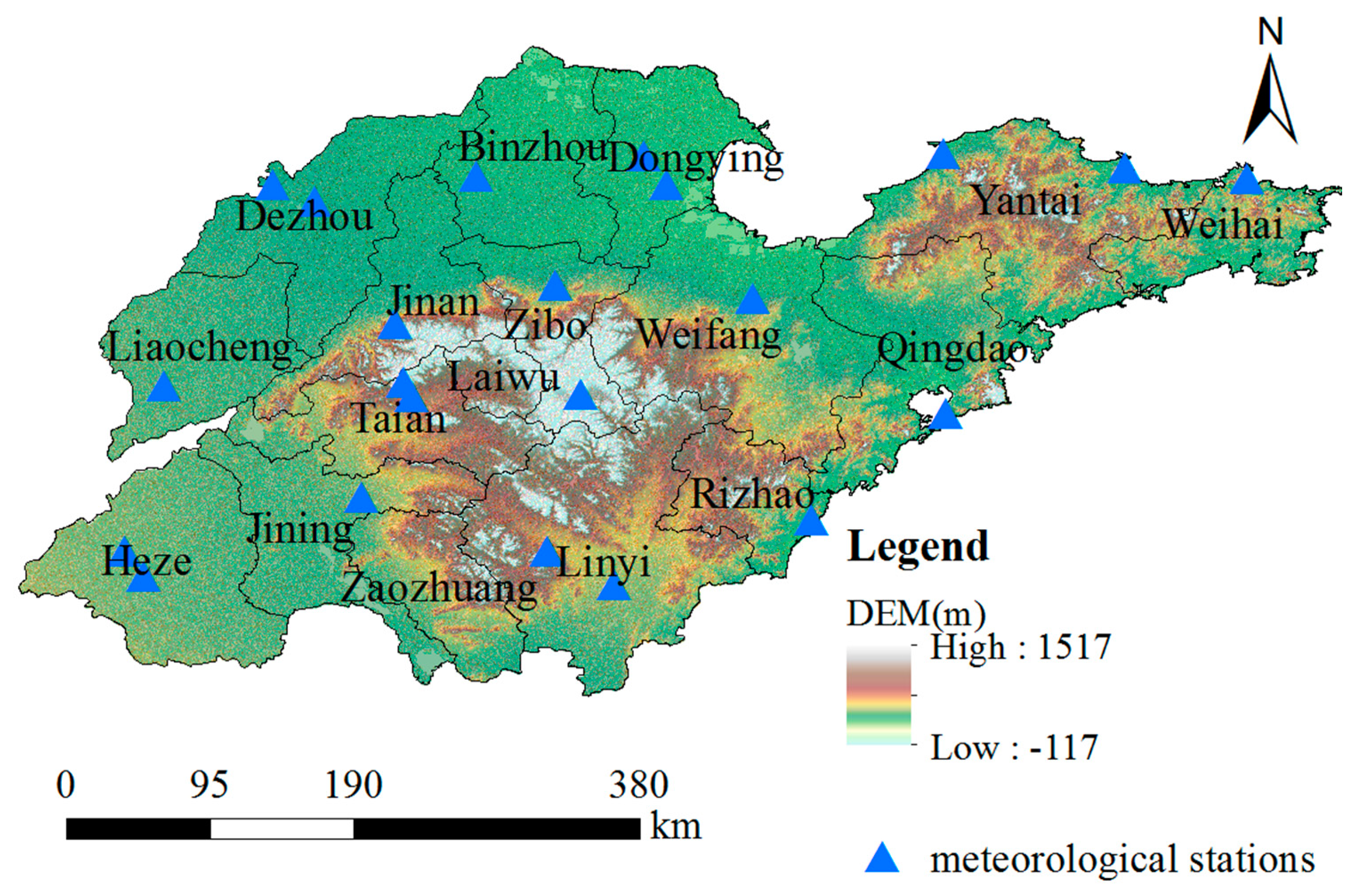
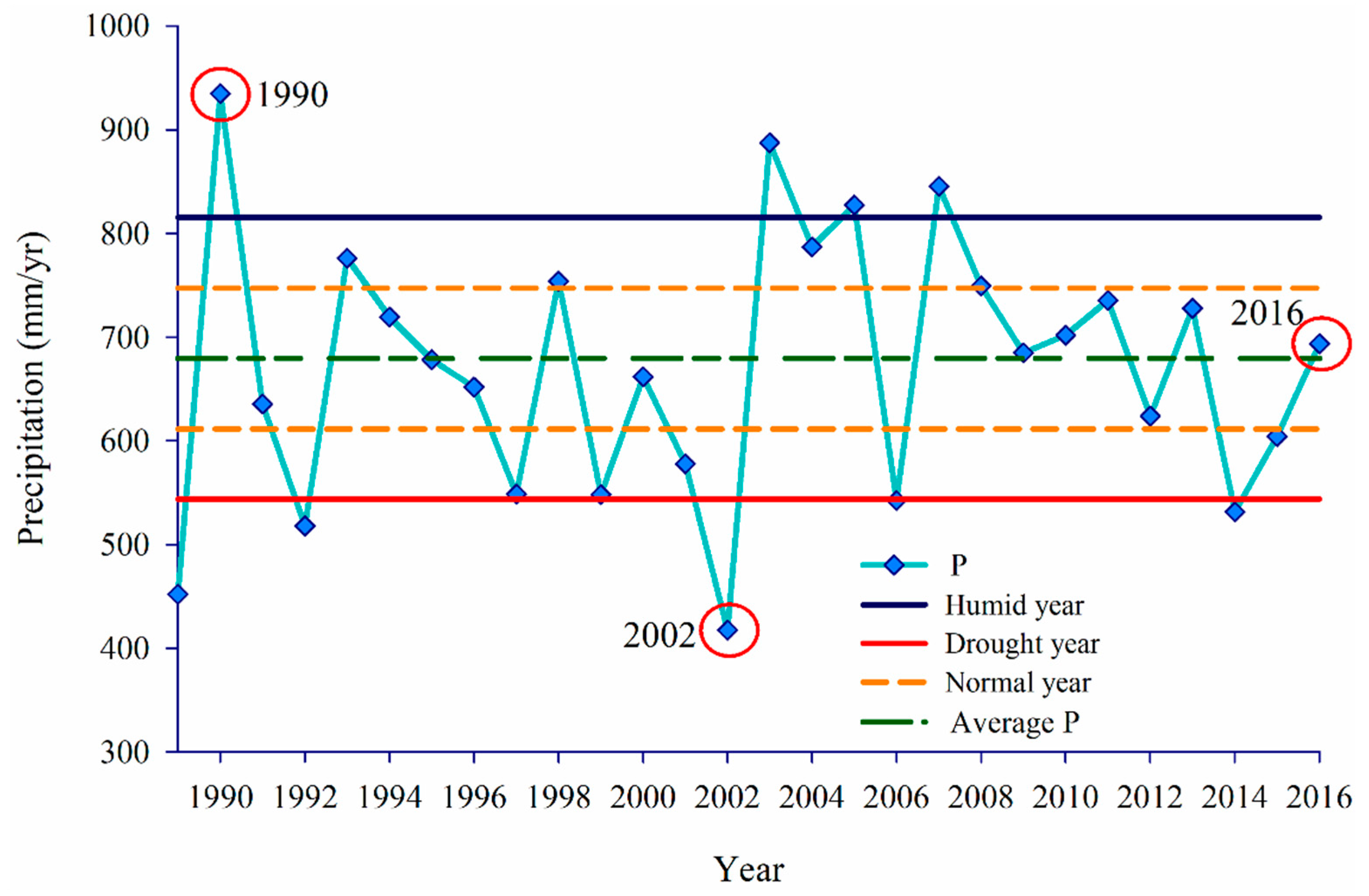


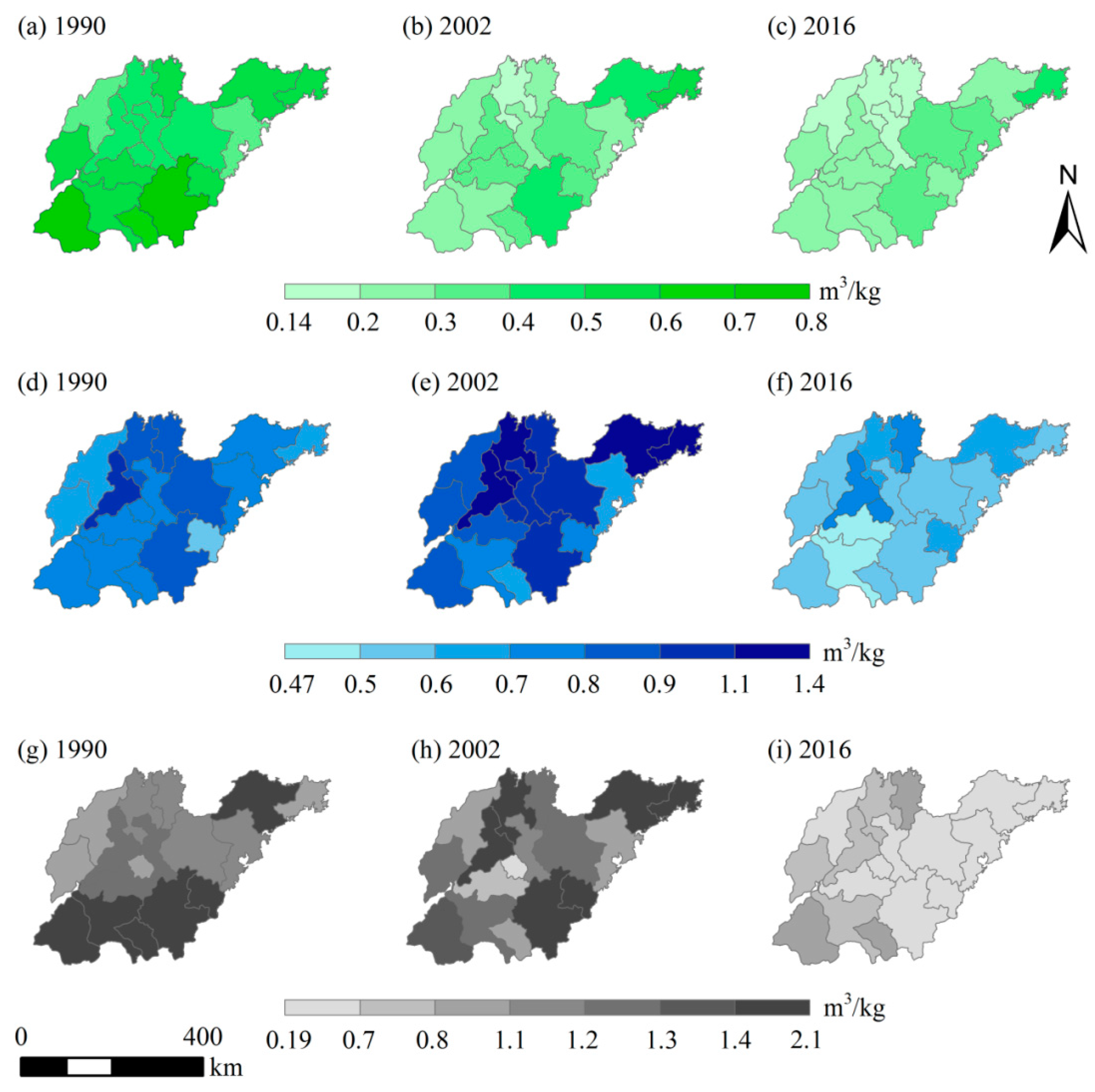
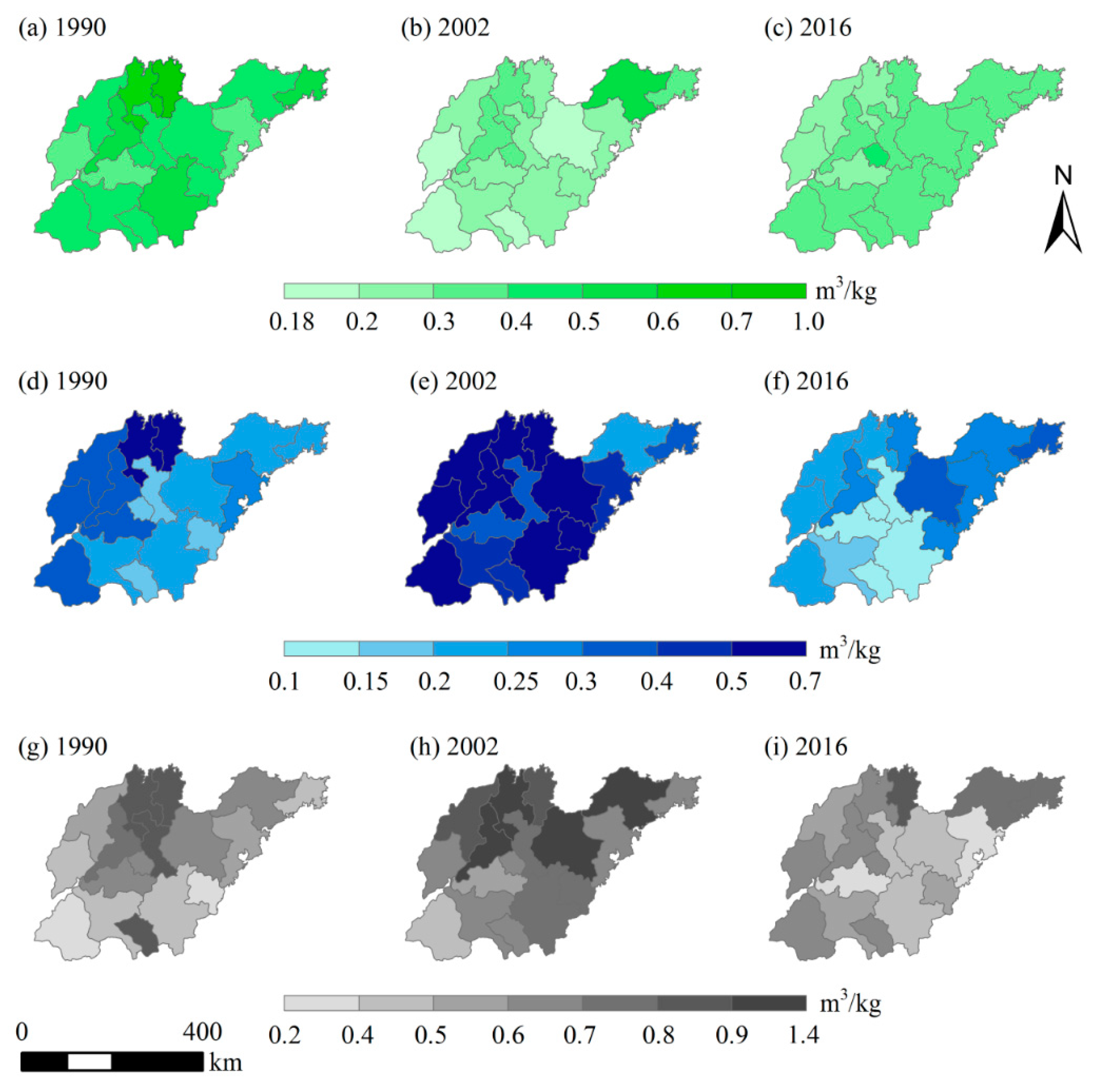
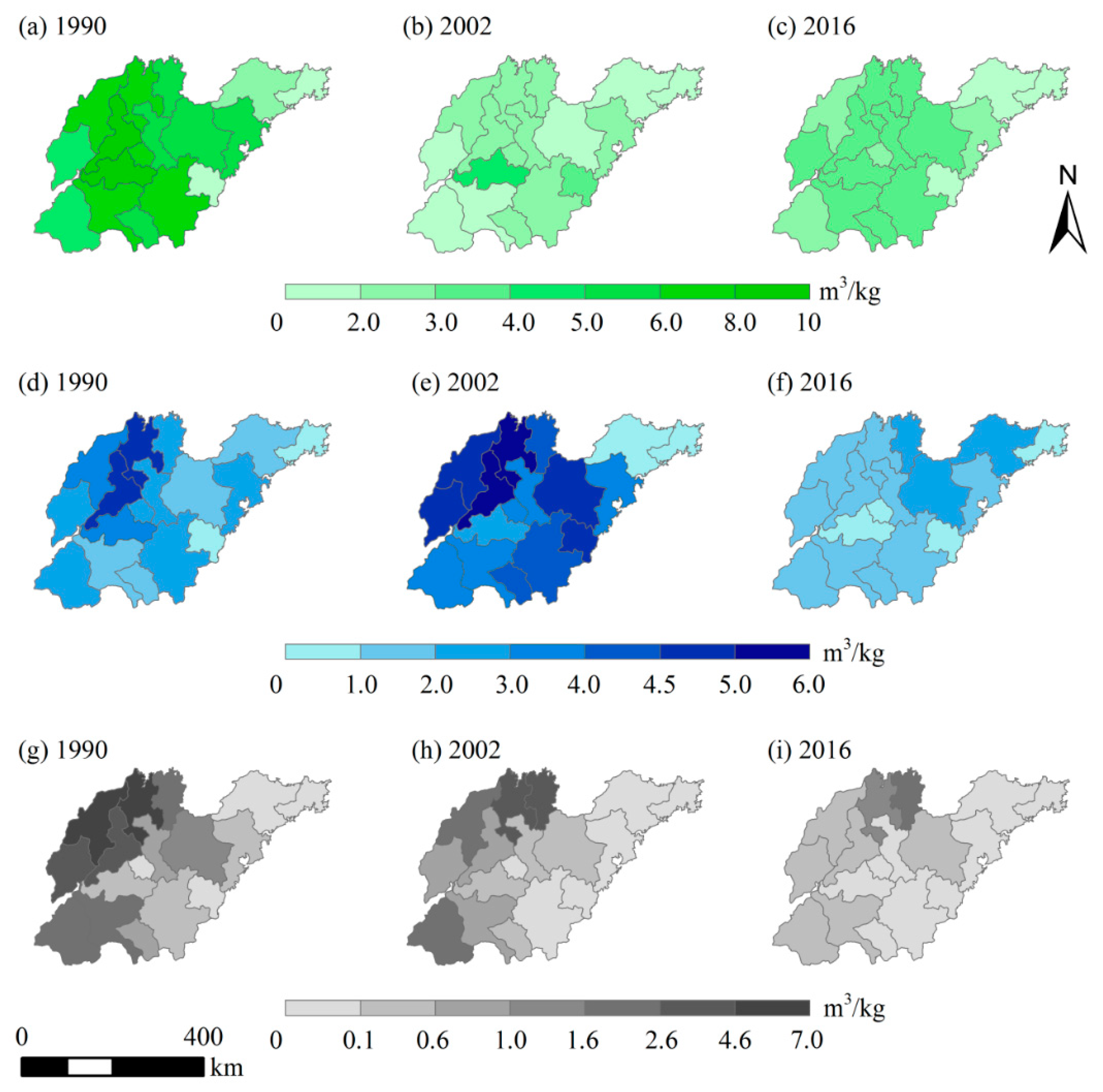
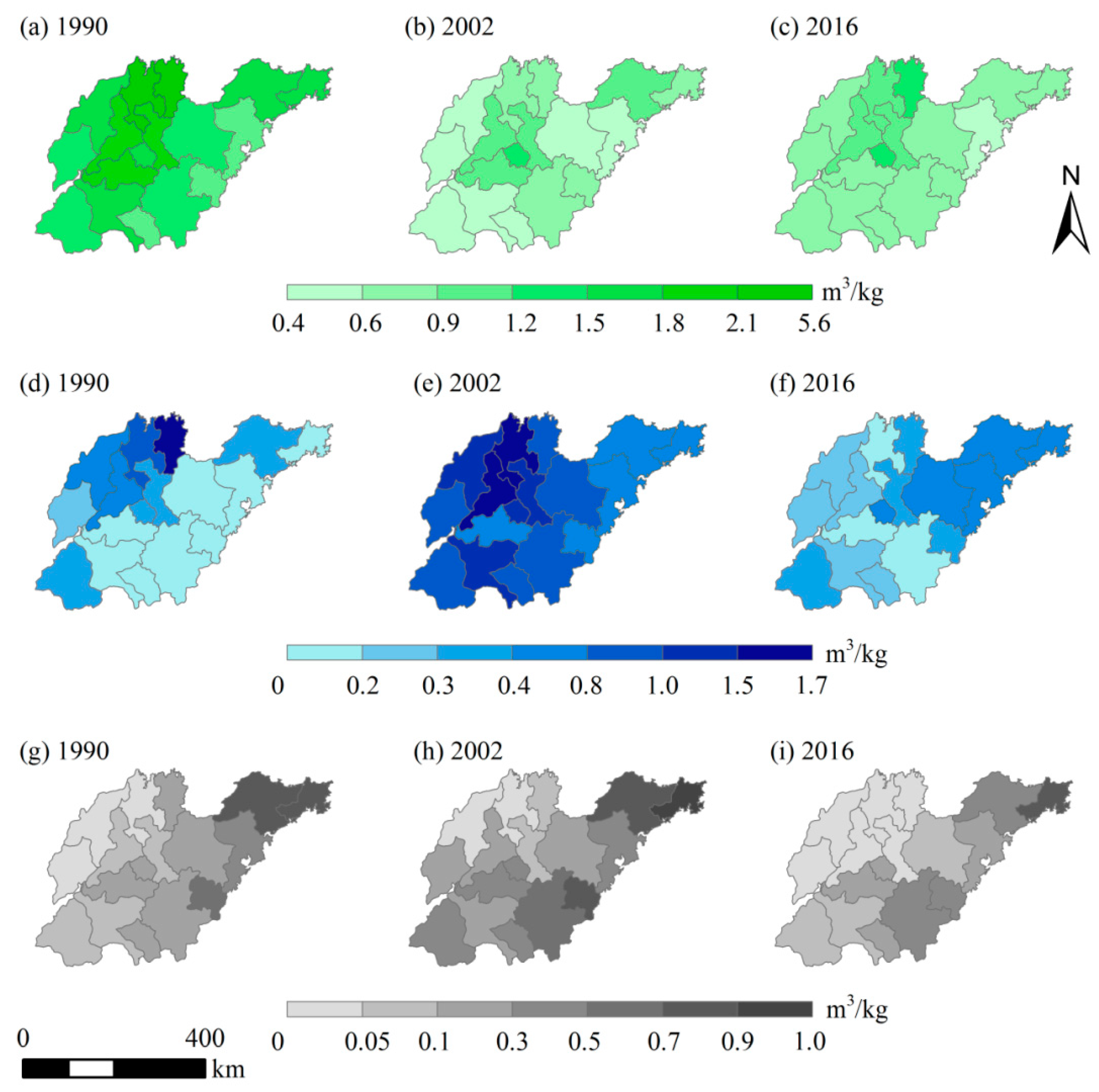

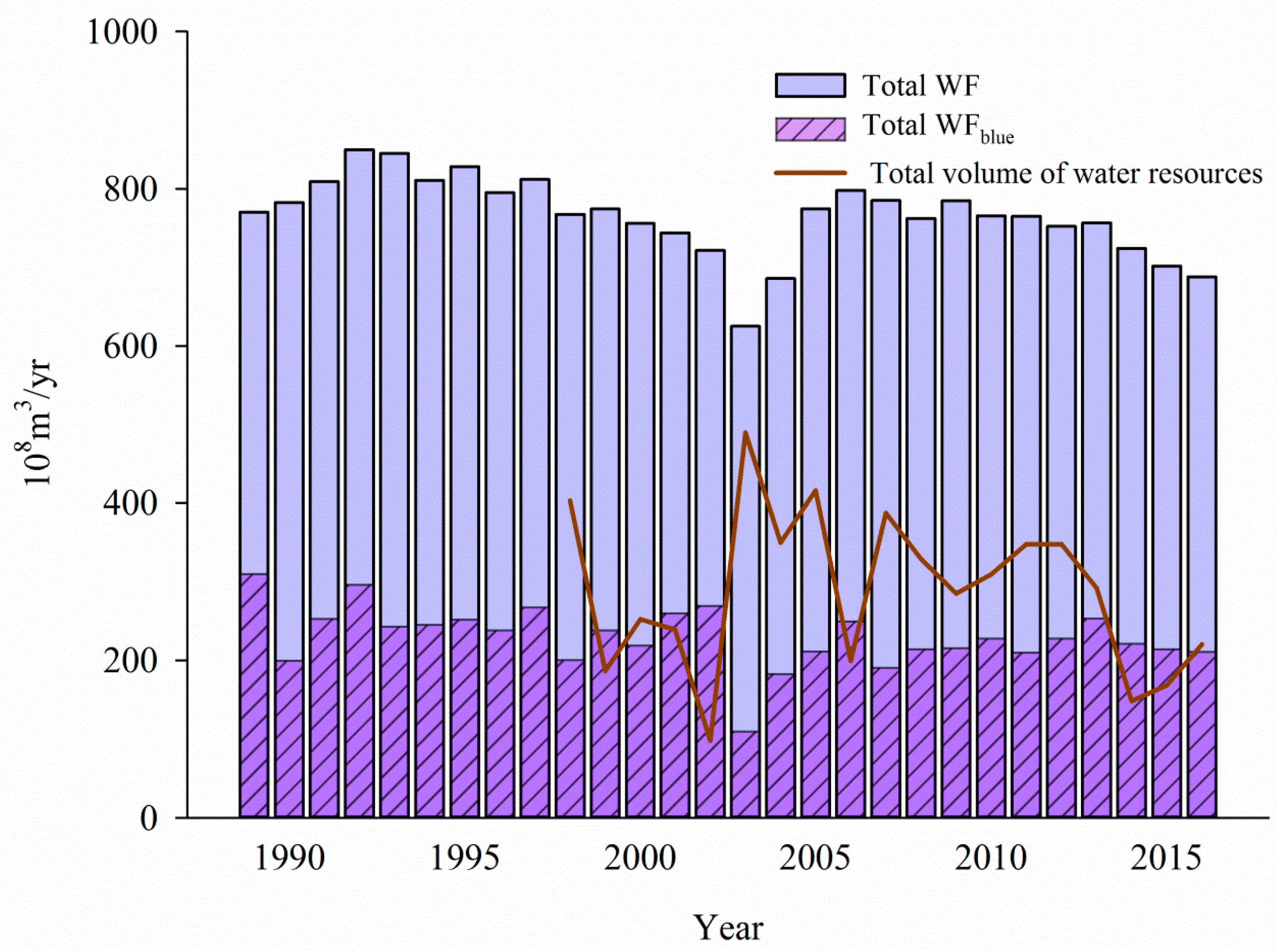


© 2019 by the authors. Licensee MDPI, Basel, Switzerland. This article is an open access article distributed under the terms and conditions of the Creative Commons Attribution (CC BY) license (http://creativecommons.org/licenses/by/4.0/).
Share and Cite
Fu, M.; Guo, B.; Wang, W.; Wang, J.; Zhao, L.; Wang, J. Comprehensive Assessment of Water Footprints and Water Scarcity Pressure for Main Crops in Shandong Province, China. Sustainability 2019, 11, 1856. https://doi.org/10.3390/su11071856
Fu M, Guo B, Wang W, Wang J, Zhao L, Wang J. Comprehensive Assessment of Water Footprints and Water Scarcity Pressure for Main Crops in Shandong Province, China. Sustainability. 2019; 11(7):1856. https://doi.org/10.3390/su11071856
Chicago/Turabian StyleFu, Mengran, Bin Guo, Weijiao Wang, Juan Wang, Lihua Zhao, and Jianlin Wang. 2019. "Comprehensive Assessment of Water Footprints and Water Scarcity Pressure for Main Crops in Shandong Province, China" Sustainability 11, no. 7: 1856. https://doi.org/10.3390/su11071856
APA StyleFu, M., Guo, B., Wang, W., Wang, J., Zhao, L., & Wang, J. (2019). Comprehensive Assessment of Water Footprints and Water Scarcity Pressure for Main Crops in Shandong Province, China. Sustainability, 11(7), 1856. https://doi.org/10.3390/su11071856




